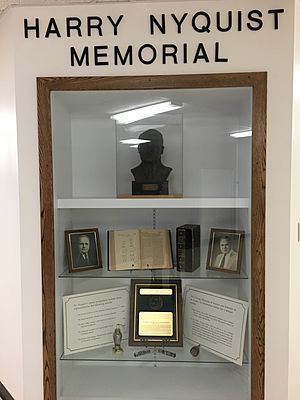Harry Nyquist facts for kids
Quick facts for kids
Harry Nyquist
|
|
|---|---|

Harry Nyquist
|
|
| Born | February 7, 1889 |
| Died | April 4, 1976 (aged 87) |
| Nationality | Swedish |
| Citizenship | Swedish / American |
| Alma mater | Yale University University of North Dakota |
| Known for | Nyquist–Shannon sampling theorem Nyquist rate Johnson–Nyquist noise Nyquist stability criterion Nyquist ISI criterion Nyquist plot Nyquist frequency Nyquist filter Fluctuation dissipation theorem |
| Awards | IEEE Medal of Honor (1960) Stuart Ballantine Medal (1960) Rufus Oldenburger Medal (1975) |
| Scientific career | |
| Fields | Electronic engineer |
| Institutions | Bell Laboratories |
| Doctoral advisor | Henry Andrews Bumstead |
Harry Nyquist (born February 7, 1889 – died April 4, 1976) was a brilliant Swedish-American scientist and electronic engineer. He made very important discoveries that helped us understand how we send information. His ideas are still used today in many communication systems, like phones and the internet.
Contents
Early Life and Moving to America
Harry Nyquist was born in a small village called Nilsby in Sweden. His parents were Lars Jonsson Nyqvist and Catarina Eriksdotter. He had seven brothers and sisters. In 1907, when he was 18 years old, Harry moved to the United States.
Harry's Education Journey
Harry started college at the University of North Dakota in 1912. He earned two degrees in electrical engineering there by 1915. After that, he went to Yale University. In 1917, he earned his Ph.D. (Doctor of Philosophy) in physics from Yale.
Working at Bell Laboratories
After finishing his studies, Harry Nyquist began working at AT&T's Department of Development and Research in 1917. This company later became famous as Bell Laboratories in 1934. He worked there until he retired in 1954.
Awards and Recognition
Harry Nyquist received many important awards for his work.
- In 1960, he received the IEEE Medal of Honor. This award recognized his important ideas about "thermal noise," sending data, and "negative feedback."
- Also in 1960, he was given the Stuart Ballantine Medal. This was for his theories and inventions in communication systems.
- In 1969, he received the National Academy of Engineering's Founder's Medal.
- In 1975, he and Hendrik Bode were awarded the Rufus Oldenburger Medal.
Harry's Influence on Other Scientists
Harry Nyquist was known for helping other scientists think better. A book called The Idea Factory shared an interesting fact. Bell Labs found that very productive employees often shared lunch or breakfast with Harry Nyquist. He didn't give them exact ideas. Instead, he helped them think deeply and come up with their own solutions.
After he retired, Nyquist lived in Pharr, Texas. He passed away in Harlingen, Texas, on April 4, 1976.
Harry Nyquist's Key Discoveries
As an engineer at Bell Laboratories, Harry Nyquist worked on many important communication problems. These included "thermal noise," how stable "feedback amplifiers" are, and improving telegraphy, fax machines, and television.
Early Fax Machines
With another scientist named Herbert E. Ives, Harry helped create AT&T's first fax machines. These machines were shown to the public in 1924.
Understanding Feedback Amplifiers
In 1932, he wrote a very important paper about how stable "feedback amplifiers" are. An amplifier makes a signal stronger. "Feedback" is when part of the output signal is sent back to the input. Nyquist's ideas about stability are now taught in many textbooks. This is called the Nyquist stability criterion.
Laying the Groundwork for Information Theory
Harry Nyquist also did early work on how much information could be sent through a communication channel. This work was very important for later discoveries by Claude Shannon, which led to "information theory."
Nyquist found that the number of separate signals (like pulses in a telegraph) that could be sent through a channel in a certain time is limited. It's limited to twice the "bandwidth" of the channel. Bandwidth is like the size of the "pipe" that carries the information. He published these findings in papers in 1924 and 1928. This rule is similar to what we now call the Nyquist–Shannon sampling theorem. This theorem helps us understand how to perfectly rebuild a signal from samples.
Terms Named After Harry Nyquist
Many important terms in science and engineering are named after Harry Nyquist:
- Nyquist rate: This is the speed at which you need to "sample" a signal. If you sample at least twice as fast as the signal's highest frequency, you can perfectly rebuild the original signal.
- Nyquist frequency: This is half of the sampling rate. Any signal frequencies below this value can be clearly represented without confusion.
- Nyquist filter: A special type of filter used in communication systems.
- Nyquist plot: A graph used to study the stability of systems, especially feedback systems.
- Nyquist ISI criterion: A rule that helps engineers design systems to avoid "inter-symbol interference" (ISI). ISI happens when one signal pulse interferes with the next.
- Nyquist (programming language): A computer language used for sound synthesis and analysis.
- Nyquist stability criterion: A mathematical rule used to figure out if a feedback system will be stable or unstable.
See also
 In Spanish: Harry Nyquist para niños
In Spanish: Harry Nyquist para niños


